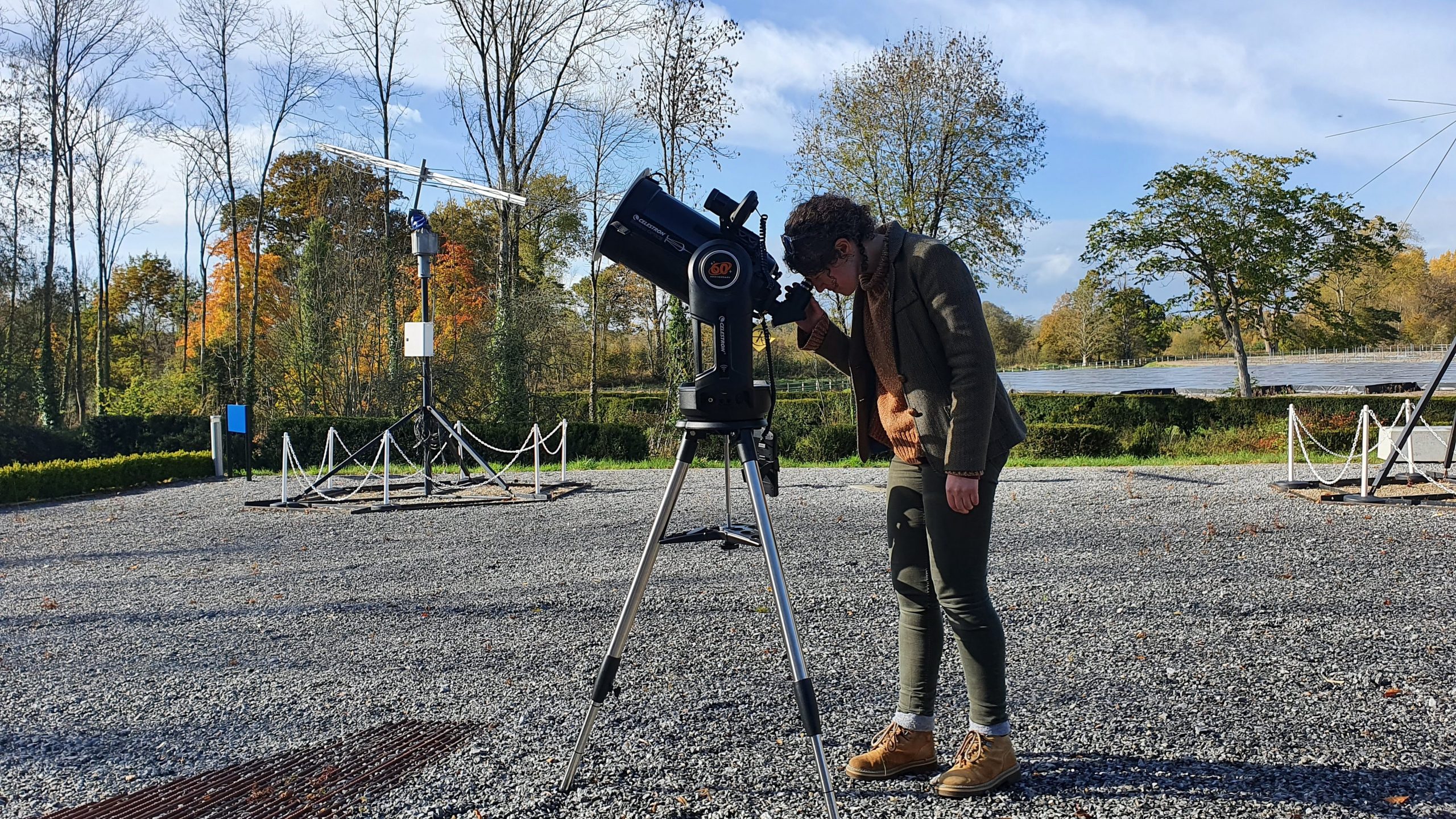
New Telescopes
blog post by Jeremy Rigney
The most well-known telescope at the I-LOFAR site is undoubtedly I-LOFAR itself, the football pitch sized radio antenna array that lies within the grounds of the Birr Castle Demesne. The majority of the telescopes currently at the I-LOFAR site (known as Rosse Observatory) are radio antenna, observing the sky in wavelengths of light ranging from centimetres to metres.
However, earlier this year I-LOFAR took delivery of two new, smaller optical telescopes from KTEC Telescopes for education and public engagement, and supported by the Science Foundation Ireland Discover 2020 Astronomical Midlands programme. This is a good opportunity to describe how these optical telescopes work, and to discuss their differences to LOFAR and similarities to more traditional radio-dish antennae.
The Schmidt-Cassegrain Telescope
A Cassegrain reflecting telescope comprises of a large concave light gathering mirror with a hole in the center. This primary mirror reflects light from the source being observed to a smaller convex mirror in front of it. This secondary mirror reflects and focuses the light through the central hole of the primary mirror and into an eyepiece lens system. A Schmidt corrector lens can be placed in front of the primary mirror to correct for spherical aberration. Spherical aberration occurs when light reflected from the edge of a concave mirror does not meet at the same point as light reflected from closer to the center. This can lead to a blurry image when the light is re-aligned through the eyepiece.

[Left] Light rays through a Cassegrain telsecope design. [Right] The addition of a Schmidt Corrector Lens to account for spherical abberation. This is the design of the Celestron. (Image modified from schoolphysics.co.uk)
The Cassegrain design can be used in both optical and radio-dish telescopes, an example of this can be seen at the 140 foot radio telescope in Greenbank, West Virginia, USA.
I-LOFAR now has an 8-inch Schmidt-Cassegrain Celestron NexStar Evolution 8HD telescope with Starsense. We were lucky enough to obtain the 60th anniversary edition from KTEC! The primary mirror is 8-inches (approx. 20.3cm) in diameter, which allows you to see objects over 4,500 times dimmer than you can see unaided. Starsense is an automated alignment system to quickly find the desired source. This telescope came with a number of filters useful for astronomical imaging. Certain wavelengths are characteristic of processes occurring in space. For example, the Hydrogen alpha line, a red wavelength at precisely 656.28 nanometers, helps determine the rate of star formation in nebulae within the galaxy. The Celestron telescope also has a white light solar filter, allowing you to stare directly at the sun (through the eyepiece) during the day. In addition to this, I-LOFAR also now has a dedicated solar telescope.
The Refracting Solar Telescope
The Lunt LS60THa/B1200PT solar telescope is refracting telescope. It uses lenses instead of mirrors to focus the light to an eyepiece. As this telescope is looking at the brightest object in the sky (the sun is 400,000 times brighter than a full moon), a number of special filters are required to protect the observer’s eye. Many amateur solar telescopes observe the sun in the Hydrogen-alpha wavelength. Much more detail can be observed in this region, which highlights the chromosphere. Prominences, spicules, filaments and flares are all visible at this level of the sun. A special filter is used to only allow the hydrogen alpha wavelength of light to pass through. Observing with this filter reduces the intensity of the light, however an Etalon filter is also required. An Etalon filter rejects any scattered light and any other wavelengths outside the desired Hydrogen alpha wavelength range of approximately 1 angstrom, or 0.1 nanometers. Dark filters may also be used to further reduce the intensity for safe viewing through the eyepiece.

The design of a solar telescope, using lenses to focus the light and filters to reduce the intensity.
I-LOFAR is very different to these traditional telescope designs. It is a radio antenna array, with no moving parts. LOFAR uses software to delay signals from its antennas, creating a ‘beam-like’ shape of sensitivity to a small region in the sky. What’s more, many of these antennas across Europe can be pointed to the same source, and their signals combined to form a telescope dish almost 2,000 km in diameter. LOFAR is also sensitive to much longer wavelengths than the optical telescopes mentioned above. It therefore observes different processes in the universe, and from the sun, that emit in radio.
Both the Celestron and solarscope were supplied by Ktec telescopes, their website is ktectelescopes.ie. The telescopes were funded through the Science Foundation Ireland Discover programme. An excellent article on observing the sun with the same solar telescope can be read here. Another equally brilliant blog by Professor Ian Morrison can be found here His blog goes into much more detail about the internal workings of the solar telescope and best practices to achieve high resolution solar images in Hydrogen alpha. The diagram of the solar telescope is also credited from this blog

The new Celestron Scmidt-Cassegrain telsecope with a solar filter on a bright sunny day at I-LOFAR

The new solarscope outside the Education Centre at I-LOFAR
.

The 140 ft radio telescope at Greenbank has a Cassegrain design, with the radio waves reflecting from the large concave dish to a smaller convex, then down the central barrel. It was used for scientific observations until 2001, then used as a communications link for the Specktr-R satellite until 2019.


